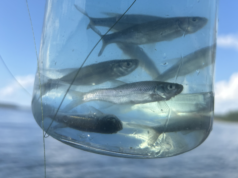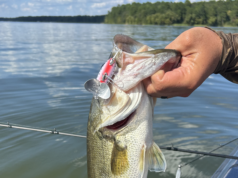by Loyd Leon
Crappie fishing is a popular pastime enjoyed by anglers of all skill levels. These elusive and delicious panfish are known for their finicky behavior, often requiring strategic approaches to lure them into biting. One highly effective technique for targeting crappie is using crankbaits. In this comprehensive guide, we will explore the ins and outs of using crankbaits for crappie fishing, covering everything from selecting the right lures to presentation techniques and fishing strategies.
Understanding Crankbaits and Crappie Behavior:
Crankbaits are versatile fishing lures designed to imitate baitfish, insects, or other prey species. They typically feature a diving lip or bill that causes the lure to dive and swim in a lifelike manner when retrieved through the water. Crankbaits come in various shapes, sizes, colors, and diving depths, allowing anglers to target fish at different depths and in various water conditions.
Crappie are notorious for their preference for structure and cover, such as submerged brush piles, fallen trees, weed beds, and rocky shorelines. They often use these features for ambush points and protection from predators. When using crankbaits for crappie fishing, it’s essential to understand their behavior and habitat preferences to effectively target them.
Choosing the Right Crankbaits for Crappie Fishing:
Selecting the appropriate crankbaits for crappie fishing requires consideration of several factors, including water depth, water clarity, forage availability, and fishing conditions. Here are some tips for choosing the right crankbaits for targeting crappie:
1. Size and Profile: Choose crankbaits that closely resemble the size and profile of the baitfish or prey species present in the area. Crappie have relatively small mouths, so opt for smaller-sized crankbaits in the 1/8 to 1/4-ounce range to match their forage preferences.
2. Diving Depth: Pay attention to the diving depth of the crankbaits and select lures that dive to the appropriate depth for the water you’re fishing. Crappie can be found at various depths throughout the water column, so having crankbaits that can reach the desired depth is essential for success.
3. Color Selection: Consider water clarity and light conditions when choosing crankbait colors. In clear water, natural or translucent colors like silver, white, and shad patterns are effective. In stained or murky water, opt for brighter, more visible colors like chartreuse, yellow, or orange to attract the attention of crappie.
4. Action and Rattle: Choose crankbaits with a subtle wobbling action and a quiet or subtle rattle for finesse presentations in calm or pressured waters. In more turbulent or noisy environments, opt for crankbaits with a more aggressive action and louder rattles to trigger strikes from aggressive crappie.
Presentation Techniques for Crappie
Once you’ve selected the right crankbaits for crappie fishing, it’s essential to use the proper presentation techniques to entice strikes from these wary fish. Here are some effective presentation techniques to consider:
1. Casting and Retrieving: Cast your crankbait parallel to shoreline structure, submerged cover, or drop-offs where crappie are likely to be holding. Use a steady retrieve with occasional pauses and twitches to mimic the erratic movement of injured baitfish, triggering reaction strikes from nearby crappie.
2. Vertical Jigging: Vertical jigging with crankbaits can be highly effective for targeting suspended crappie holding near submerged brush piles, bridge pilings, or standing timber. Drop your crankbait directly below the boat and jig it up and down in short, erratic motions to entice strikes from crappie suspended at various depths.
3. Trolling: Trolling crankbaits behind a slow-moving boat allows you to cover a large area of water and locate active crappie schools. Use planer boards or downriggers to spread out your trolling spread and present multiple crankbaits at different depths simultaneously. Adjust your trolling speed and lure depth until you find the optimal combination for triggering strikes.
4. Drifting and Drift Fishing: Drifting with crankbaits is an effective technique for covering expansive areas of open water or drifting along windblown shorelines. Use drift socks or a trolling motor to control your drift speed and direction, allowing your crankbait to swim naturally with the current and cover a wide range of depths and structures.
Fishing Strategies
for Crappie Success:
In addition to selecting the right crankbaits and using proper presentation techniques, employing effective fishing strategies can significantly increase your chances of success when targeting crappie. Here are some strategies to consider:
1. Location Scouting: Spend time scouting and identifying potential hotspots for crappie, such as submerged brush piles, standing timber, bridge pilings, weed beds, and drop-offs. Use electronics to locate schools of crappie and pinpoint their precise locations.
2. Weather and Seasonal Patterns: Pay attention to weather patterns, water temperature, and seasonal trends when planning your crappie fishing trips. Crappie are more active during low light conditions such as dawn, dusk, and overcast days, so plan your fishing trips accordingly. In spring, focus on shallow spawning areas, while in summer, target deeper water near thermoclines and structure.
3. Experimentation and Adaptation: Be willing to experiment with different crankbaits, colors, sizes, and presentations until you find what works best on a given day. Crappie can be finicky and unpredictable, so it’s essential to adapt your tactics based on changing conditions and fish behavior.
4. Persistence and Patience: Crappie fishing can be challenging at times, requiring patience, persistence, and perseverance. Stay focused, confident, and attentive to subtle strikes or bites, as crappie often exhibit light or tentative feeding behavior. Don’t be discouraged by slow periods or missed opportunities; instead, stay persistent and keep adapting until you find success.
Using crankbaits for crappie fishing is a rewarding and effective technique for targeting these prized gamefish. By understanding the behavior of crappie, selecting the right crankbaits, mastering presentation techniques, and employing effective fishing strategies, anglers can increase their chances of success and enjoy memorable days on the water. Whether you’re casting along shoreline structure, vertical jigging near submerged cover, trolling open water, or drifting along windblown shores, crankbaits can be a versatile and productive lure choice for crappie fishing. So grab your gear, tie on your favorite crankbait, and get ready to reel in some slab-sized crappie on your next fishing adventure!












